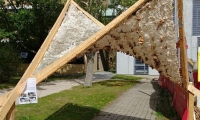During decades we’ve produced materials by extracting finite valuable resources without taking their end of the life and environmental impact into account. Plastic, concrete and synthetic composites are examples of such materials. What if we could grow building materials that are fully biodegradable after their use? How can we translate the qualities of nature, like self-organisation, adaptation, self-repair and resilience, considering that in design and architecture we often strive for predictability, controlled processes and clear results, which isn’t always the case with growing organisms?
Driven by a fundamental change in architectural design approach this research is centred on cultivating materials with living organisms on by-products of agriculture. Those living materials are composites of natural reinforcement, such as agricultural plant residues fibres, and fungal mycelium (the root structure of mushrooms). It acts as a complex and resourceful three-dimensional network, similar to a woven fabric, binding natural substrate into lightweight composite materials which are fully compostable and suitable for various industries, such as the building sector.
The goal of this research is to deposit and engineer the material heterogeneity of the living matter, allowing variations in thickness, strength, and flexibility within a single fabrication. Therefore, we will distil the morphological and metabolic production principle of filamentous mycelial microorganisms and associate it with the growth of bioinspired man-made tissues and composite materials. The classification of those processes of biological optimization will allow us to understand the key factors that determine the production, properties, and performance of living materials suitable for lightweight architectural structures. The end result will be the investigation and development of innovative lightweight architectural elements made with biologically grown composites, by applying novel robotic additive manufacturing techniques. Combining the use of computer-aided 3D printing fabrication with the use of natural grown abundant materials, sustainable products and building elements can be manufactured using low energy and in mild conditions. Applications of this research are, for example, fully bio-degradable temporary pavilions, emergency shelters, building skins, insulation, interior elements and furniture. This research engages a strategic transition towards a circular bio-based society, providing a sustainable response to environmental issues and wasted resources in the built environment.


